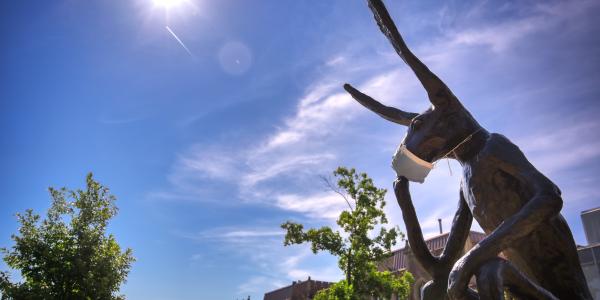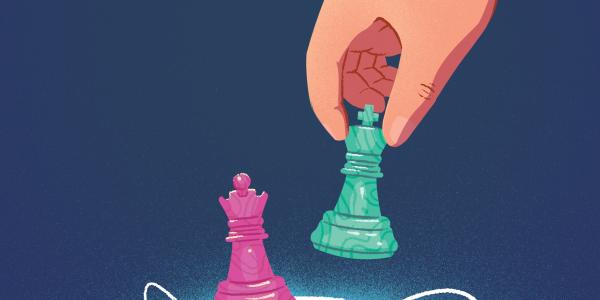This month, the College of Arts & Sciences offers undergraduates a new interdisciplinary course, titled “The Pandemic: Science and Society.” The intensive three-week course that starts on August 17 will give students from across the university the opportunity to learn about the pandemic as it unfolds.
The sheer volume of COVID-19 information that is continuously published, broadcast, and discussed across social media has made it increasingly difficult to separate fact from fiction. Krista Milich, an assistant professor of biological anthropology in Arts & Sciences, has spent years studying environmental impacts on health, including zoonotic diseases, but this aspect of COVID-19 is unlike anything she has seen.

“I have a project studying Zika virus, and I remember when ZIKV was first emerging in the Americas, it felt difficult to keep up with the literature,” Milich said. “That was nothing compared to COVID-19. There is an overwhelming amount of information being shared every day.”
Milich's scholarship on Zika revealed that distilling accurate information about a public health crisis is an essential, but difficult task. As the current pandemic unfolds, she wanted to help students discover and navigate the many medical and societal effects of COVID-19.
Beginning Aug. 17, Milich and collaborators will guide undergraduates through this wide array of data in a unique new course, titled “The Pandemic: Science and Society.” The course, originally envisioned by Feng Sheng Hu, dean of the faculty of Arts & Sciences, will bring together diverse perspectives on the pandemic and its ongoing effects, which have upended nearly every aspect of society.
The course will showcase the expertise of faculty from across the university and from institutions and organizations throughout the country. Featured speakers currently include David Wang (WashU School of Medicine) on the science of the virus; Shanti Parikh (Arts & Sciences) on cultural perspectives and the stigmas of testing; Heather Bennett (Sam Fox School of Design & Visual Arts) on empathy and the pandemic's impact on the arts; Pauline Kim (WashU Law) on employment law and the pandemic's effects on essential workers; Joshua Sharfstein (The Johns Hopkins University) on leadership and management in a public health crisis; Chancellor Andrew D. Martin on COVID-19's impact on higher education; Ed Yong (The Atlantic) on science communication; and many other local and national experts.
“Students in the course will have the opportunity to process this information with the help of expert faculty members, while developing skills for thinking critically about fast-evolving situations,” said Hu. “Many of us are already trying to keep up with this news and information on our own. Why not do this for credit, with guidance from reliable experts?”
“I hope that seeing how pervasive the effects of the pandemic are will encourage everyone to be thoughtful about their behaviors — to really understand what they need to do to protect themselves and others and to help move toward ending this pandemic.”
Milich hopes that students who take the course will be able to engage with these materials, understand them, and even ask questions of the experts who are helping to produce them. Over the course of three weeks, undergraduates will investigate not only the biology behind the virus itself, but also how it intersects with society and impacts daily life.
By understanding the scope of the pandemic’s devastation, Milich said, students will consider the part they each play in recovery and mitigation efforts going forward. “I hope that seeing how pervasive the effects of the pandemic are will encourage everyone to be thoughtful about their behaviors — to really understand what they need to do to protect themselves and others and to help move toward ending this pandemic.”

The first section of the course will focus on the virus and illness itself: the scientific classification, possible treatments and vaccines, testing, safety measures, at-risk groups and health outcomes for different groups, and context for understanding the number of people affected. This section will incorporate lessons on interpreting and evaluating scientific information, understanding how information gets communicated to the public, and learning how it is incorporated into policy.
The second section will integrate connections to society at large, including global perspectives, the effects of agricultural systems and environmental destruction on disease outbreaks, and variations in effectiveness of response across different countries. This section will also examine issues like racism and COVID-19. “It has become increasingly evident that the pandemic has disproportionately affected marginalized communities,” Milich emphasized. “The way COVID-19 proliferates through our society is heavily influenced by historical disparities that affect health, wealth, and much more.”
The final section will cover how the pandemic intersects with different aspects of our daily lives, such as finance, law, mental health, education, domestic violence, and the arts. Students will hear experts in these areas discuss how COVID-19 has changed virtually every aspect of life as we know it, how we can mitigate these effects, and what the future may look like.
Jen Smith, dean of the College of Arts & Sciences, realizes that this future will be led by current undergraduate students, and she wants students to come away from the course with a desire to contribute to the fight for positive change. “I hope students will be inspired by the work of experts across and beyond our university to understand COVID-19 and mitigate its effects — inspired enough to come up with their own ideas for public outreach, scientific research, or a creative contribution to help our community navigate the ongoing challenges caused by the virus,” she said.
The two-credit course, which has drawn unprecedented student interest and has more than 800 registrants so far, will run for three weeks, from Aug. 17 – Sept. 4. It will meet Monday through Friday from 1– 2:50 p.m. CDT in an entirely virtual format, with asynchronous participation options available. It is open to all undergraduate students, at any level and from any school, and may be taken for a grade, as pass-fail, or audited. Registration will close Aug. 19.





